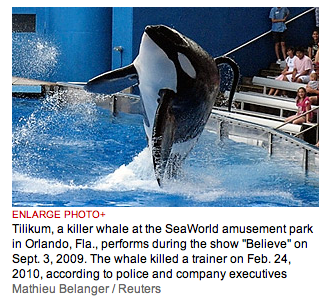Killer-Whale Tragedy: What Made Tilikum Snap?
 By Jeffrey Kluger, courtesy of TIME
By Jeffrey Kluger, courtesy of TIME
Something about SeaWorld trainer Dawn Brancheau’s ponytail may have triggered the attack. That’s what an official at the Orlando marine park told reporters the day after the 16-year veteran at SeaWorld was killed by Tilikum, a 12,000-lb. (5,500 kg) killer whale. On Feb. 24, in the middle of an otherwise routine show, the 40-year-old trainer was standing at the edge of a tank when the 29-year-old animal leaped from the water, grabbed her by the ponytail and began thrashing her about. As horrified visitors watched both from around the tank and from the viewing window below, Tilikum then dragged Brancheau underwater to her death.
Officials treated the death as a homicide — though one with a decidedly uncommon perpetrator — and within two days, investigators had been to the scene, sorted out the rapid-fire sequence of events that led to the death and essentially closed their books on the case. But the question that remained unanswered — in addition to the matter of what should be done with Tilikum now — is why the animal lashed out. What goes on in the mind of so complex a creature that causes it to become so fierce so fast — and is there anything that can be done to prevent such tragedies? (See 10 infamous animal attacks on humans.)
Tilikum is not a first-time offender. In 1991 — eight years after he was captured off the coast of Iceland — he and two other killer whales drowned a trainer during a performance at Sealand of the Pacific in Vancouver. In 1999, a man who trespassed in SeaWorld after hours and apparently jumped in the whale tank was found dead the next morning, lying across Tilikum’s back. Is the big whale a bad seed? At least one marine-mammal expert thinks that yes, that’s at least part of the answer.
"When Tilikum was wild, he was a transient, not a resident," says Russ Rector, a former dolphin trainer who is now a fierce opponent of keeping any dolphins or whales in captivity. "Resident whales are the kind that live in a fixed place, like Puget Sound. Transients travel the world, eating dolphins, fish, other whales, basically anything that gets in their way." Such animals need to be particularly aggressive, both to establish territoriality when they’re passing through and to hunt such a wide range of large prey. Those are traits that don’t go away.
Of course, plenty of killer whales live in captivity and never do anything like what Tilikum has done. What was it about this particular whale’s experiences or environment at SeaWorld that led to the swish of a ponytail sparking such violence?
Nearly all captive zoo and park animals live far better today than they did in the horror-show era of full-grown beasts in small metal cages. But many animal psychologists argue that the landscaping and enriched environments of contemporary zoos are as much for the benefit of human visitors as anything else. The array of dysfunctional behaviors on display at even the best zoos — from swaying giraffes to pacing big cats to the compulsive back-and-forth swimming of Gus, the famously neurotic polar bear in New York’s Central Park Zoo — illustrate the psychologists’ point. Trying to improve conditions is hard enough with small to midsize animals like cheetahs and lions; with a leviathan like a killer whale, whose enclosure can only get so big, it’s nearly impossible. (See a 2006 story about a killer-whale attack in San Diego.)
"You can’t enrich these environments," says Rector. People for the Ethical Treatment of Animals used the occasion of Brancheau’s death to issue a press release expressing a similar sentiment, demanding that parks "stop confining ocean-going mammals to an area that to them is like the size of a bathtub."
Not everyone within the whale-studying community takes such a dim view of SeaWorld and other such places. Bernd Wursig, a professor of marine biology at Texas A&M University, acknowledges that the sheer size of whales makes them hard to accommodate well, but that doesn’t mean it can’t be done. "I don’t buy the idea that confinement is what was responsible for Tilikum," he says. "I prefer to see animals in nature, but when they were born in captivity or have been in captivity so long, that socialization is the only one they know."
Wursig suspects Tilikum lashed out for much the same reason that humans lash out. "Even though whales are bright and very well trained, they can show aggressivity if they feel threatened or if they’re in a bad mood," he says. "It can also be displacement, if they haven’t had a good time with their pod members."
No matter what brought on this tragedy, Tilikum’s third killing has not been ruled a death-penalty crime. Though animals that kill humans, both in the wild and in captivity, are usually summarily killed themselves, that’s not a firm rule. Travis, the chimp that mutilated a Connecticut woman in 2009, was killed on the spot when police arrived at the scene. Montecore, the white tiger that attacked Roy Horn of the Seigfried and Roy performing team in 2003, was spared when Roy himself insisted on it. Tilikum, too, benefited from merciful judges. Brancheau’s relatives pleaded for mercy, and a little more than 24 hours after her death, SeaWorld announced that the whale’s life would be spared.
"We don’t know what was going through the killer whale’s head," says Chuck Tompkins, Brancheau’s former supervisor. The fact, of course, is that we never can know such things — which is what will always make keeping such beasts in the first place the dangerous business it is.


